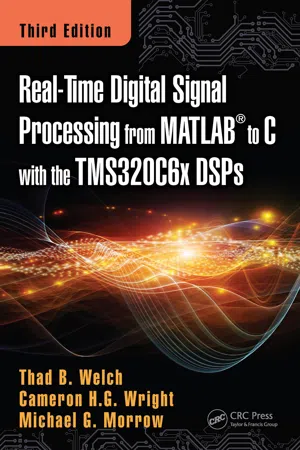
Real-Time Digital Signal Processing from MATLAB to C with the TMS320C6x DSPs
- 444 pages
- English
- ePUB (mobile friendly)
- Available on iOS & Android
Real-Time Digital Signal Processing from MATLAB to C with the TMS320C6x DSPs
About this book
This updated edition gives readers hands-on experience in real-time DSP using a practical, step-by-step framework that also incorporates demonstrations, exercises, and problems, coupled with brief overviews of applicable theory and MATLAB applications. Organized in three sections that cover enduring fundamentals and present practical projects and invaluable appendices, this new edition provides support for the most recent and powerful of the inexpensive DSP development boards currently available from Texas Instruments: the OMAP-L138 LCDK. It includes two new real-time DSP projects, as well as three new appendices: an introduction to the Code Generation tools available with MATLAB, a guide on how to turn the LCDK into a portable battery-operated device, and a comparison of the three DSP boards directly supported by this edition.
Frequently asked questions
- Essential is ideal for learners and professionals who enjoy exploring a wide range of subjects. Access the Essential Library with 800,000+ trusted titles and best-sellers across business, personal growth, and the humanities. Includes unlimited reading time and Standard Read Aloud voice.
- Complete: Perfect for advanced learners and researchers needing full, unrestricted access. Unlock 1.4M+ books across hundreds of subjects, including academic and specialized titles. The Complete Plan also includes advanced features like Premium Read Aloud and Research Assistant.
Please note we cannot support devices running on iOS 13 and Android 7 or earlier. Learn more about using the app.
Information
Section II:
Projects
Chapter 10
Project 1: Guitar Special Effects
10.1 Introduction to Projects
10.2 Theory
10.2.1 Background
Table of contents
- Cover
- Half Title
- Title Page
- Copyright Page
- Dedication
- Foreword
- About the Authors
- Table of Contents
- List of Figures
- List of Tables
- List of Program Listings
- Preface
- Acknowledgments
- Section I: Enduring Fundamentals
- Section II: Projects
- Section III: Appendices
- References
- Index